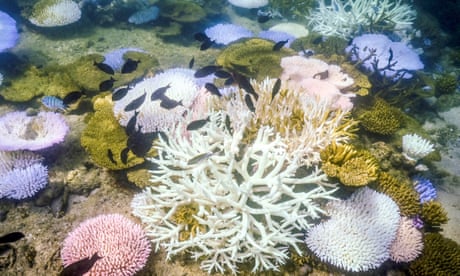
The Great Barrier Reef is in the midst of what could be its worst summer on record with a widespread and extreme coral bleaching event coming on top of floods, two cyclones and outbreaks of coral-eating starfish, according to an official Australian government report.
The “summer snapshot” report released by the Great Barrier Reef Marine Park Authority and the Australian Institute of Marine Science said: “Compared [with] previous summers, cumulative impacts have been much higher this summer and a widespread bleaching event is still unfolding.”
The report says 39% of 1,080 individual reefs surveyed from the air had experienced either very high (61-90% coral cover bleached) or extreme (more than 90%) levels of bleaching. Such high levels had been observed on reefs in all three regions of the park, which is a world heritage-listed natural wonder, but the most heat stress had occurred in the south.
The reef marine park, covering an area the size of Italy and including 3,000 individual reefs, is in the middle of a fifth mass bleaching in only eight years driven by global heating, with at least 10% of corals affected on 73% of reefs.
US government scientists confirmed this week that a fourth planet-wide coral bleaching event was under way, with many reefs in the Atlantic, Pacific and Indian oceans bleaching.
Dr David Wachenfeld, reef research program director at Aims, said: “We have seen [coral] mortality from flooding, from cyclones and from heat stress.”
Wachenfeld said while levels of heat stress had been at record levels on some parts of the reef, it would be many months before a clearer picture emerged of how many corals had died. In-water surveys are ongoing.
A separate report released by Aims said southern parts of the reef had experienced the highest levels of heat stress ever seen on the satellite record.
“Over all the sources of potential stress across the whole reef, yes, the exposure this summer is really high in most places,” said Wachenfeld. “The critical question is, how will that play out over the next year?”
Two cyclones moved across northern parts of the marine park this Australian summer, raising concerns.
Cyclones generate wave action that can damage and kill corals, as well as causing flooding in-land which can push freshwater, sediment and nutrients back out on to reefs near the shore. Some corals had died as a result, the report said.
An outbreak of the native crown-of-thorns starfish had also occurred in the southern section of the reef. The marine park authority has a program to anticipate and cull the starfish which, under an outbreak, can eat coral faster than it can grow.
Wachenfeld said: “Climate change is the by far the greatest threat to coral reefs globally and it’s a growing threat – and, not withstanding the objectives of the Paris climate agreement, we continue to emit greenhouse gases more than we used to.”
Australia is one of the largest exporters of fossil fuels – in particular coal and gas – in the world.
Dr Roger Beeden, the reef authority’s chief scientist, said it was too early to know if this summer would be the worst the reef had seen, “but it’s really significant”.
“This cumulative story is really important and across most of the reef we will see consequences,” he said.
Prof Terry Hughes, a coral bleaching expert at James Cook University in Queensland, said the evidence showed “this is the most widespread and most severe bleaching event on record”.
Data from the US government’s National Oceanic and Atmospheric Administration’s Coral Reef Watch shows the amount of heat stress accumulated on reefs around the world, using a measure called degree heating weeks.
Hughes, who has extensively studied previous bleaching events, said the NOAA data showed areas across the marine park – from Lizard Island in the north to Cairns and Port Douglas in the central area and the Whitsundays, Heron Island and Lady Elliot Island in the south – had seen heat stress between 9 and 12 DHWs.
“That’s lethal levels of heat exposure at tourism hotspots along the length of the GBR and we have never seen anything like that,” he said.
Anne Hoggett, co-director of the Australian Museum’s Lizard Island Research Station, said about 80% of the shallow Acropora corals that are known as staghorn and plate-like corals had already died.
She said: “It’s absolutely shocking. This has not ended yet and it remains to be seen how bad it will be.”
In July, the World Heritage committee is due to decide if the Great Barrier Reef should be placed on a list of sites in danger.